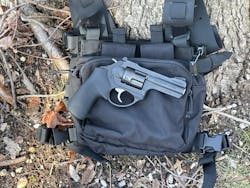A Trusty Sidearm for the Backwoods
On a recent backpacking trip I wanted to take along a handgun I felt had the necessary versatility, durability and energy delivery to be of greatest value in the backwoods. I have an assortment of 9mm handguns and my Government Model 1911 .45ACP and I even have a Smith & Wesson Model 66 4” .357Mag revolver. I didn’t feel like any of the 9mms would give me the versatility I wanted, nor the energy delivery I might need, and the 1911 and SW66 were just bigger than I wanted to carry. So I did some searching around and recalled having seen the Ruger LCRx revolver: chambered in .357 Magnum and with a 3-inch barrel (the Model 5444), I felt it would be about perfect. I procured one for field testing and it performed very well.
The versatility I desired involved having a mix of snake-shot and standard loads in the cylinder. When I took my trip it was still warm enough that I might have stumbled across some copperheads (if I didn’t pay attention) and bears weren’t yet in hibernation. I couldn’t imagine either one of them being a serious threat but you prepare for the worst, right? And there always remained the possibility of meeting human predators on some of the trails. I loaded the first two chambers with CCI Shotshells (which function in .38/.357 revolvers) and the remaining three with Federal’s Personal Defense Hydra-Shok 158g rounds. I had two speed strips carrying an additional ten rounds of the Hydra-Shok ammo.
Obviously, before hitting the trail, I took the revolver to the range to adjust the sights as necessary and get familiar with the handling/shooting characteristics. Having shot so many semi-autos for so long, I admit that the recoil and muzzle flash from the revolver was a wake-up call. Of course, I started my law enforcement career carrying a revolver so it wasn’t new; just unfamiliar—but not for long. The LCRx 3-inch was a bit bigger than I expected a 5-shot revolver to be, but only in height and length. The smaller cylinder (as compared to revolvers that carry 6+ rounds) did make the weapon noticeably thinner. It shot well out of the box and the adjustable blade rear sight was on target at 15 yards without adjustment. With an unloaded weight of 21.3 ounces, or about 1.25 pounds, it isn’t light as compared to many semi-autos either. I reminded myself that it wasn’t there to be light or small. It was there to help me deal with snakes and potential predators.
The revolver shot well. Recoil was very manageable and the Hogue Tamer Monogrip helped. The trigger was smooth with no gritty feeling to the overall pull. The ejector rod is a bit short given the length of .357 cases, but this was no problem until the weapon got hot/dirty. After about 50 rounds the spent cases started to stick a bit and we had to pull them out as they wouldn’t fall free. This would only ever be an inconvenience on the range as I wouldn’t be carrying more than 15 rounds with me on the trail and it would be clean when I headed out.
Overall, the revolver fully answered my needs. The inherent versatility of the .357 caliber combined with the added inch of barrel length (as compared to a standard “snubby” 2-inch) and the available ammo gave me everything I wanted with me in the woods. Now it’ll be my standard backwoods weapon for future backpacking expeditions. Find out more about it at www.ruger.com/products/lcrx and on our website at www.officer.com/12357046.

Lt. Frank Borelli (ret), Editorial Director | Editorial Director
Lt. Frank Borelli is the Editorial Director for the Officer Media Group. Frank brings 20+ years of writing and editing experience in addition to 40 years of law enforcement operations, administration and training experience to the team.
Frank has had numerous books published which are available on Amazon.com, BarnesAndNoble.com, and other major retail outlets.
If you have any comments or questions, you can contact him via email at [email protected].



